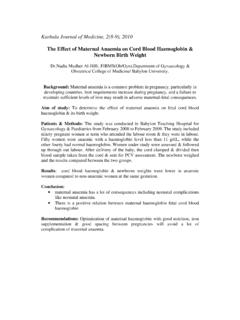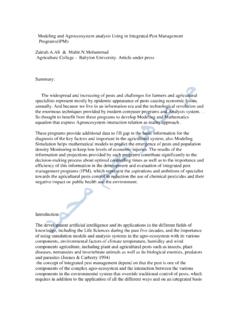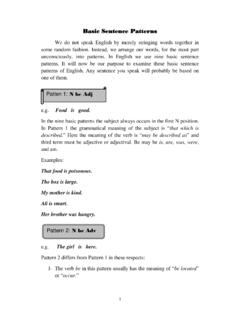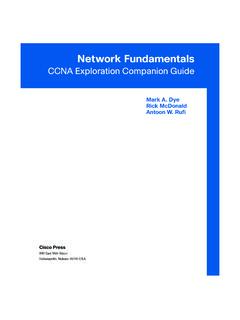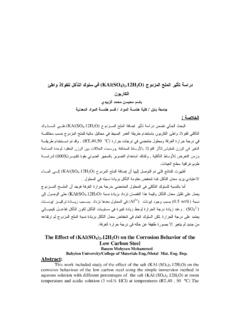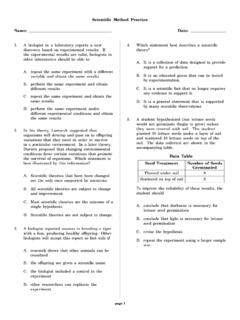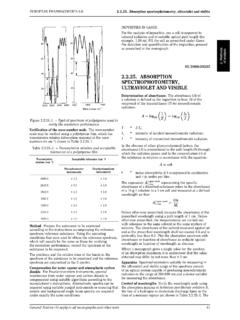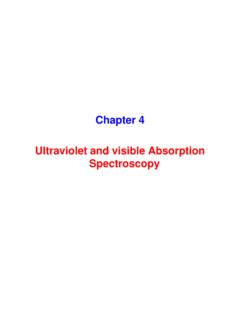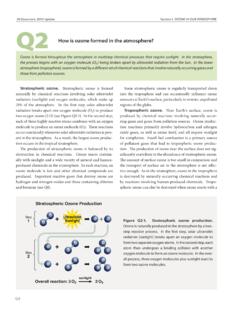Transcription of ULTRAVIOLET AND VISIBLE SPECTROSCOPY
1 ORGANIC CHEMISTRY. SPECTROSCOPY of Organic Compounds Prof. Subodh Kumar Dept. of Chemistry Guru Nanak Dev University Amritsar -143005. ( ). CONTENTS. Introduction ULTRAVIOLET and VISIBLE SPECTROSCOPY Nature of Electronic Transitions Principles of Absorption SPECTROSCOPY Spectral Measurements Solvent Effects Applications of Electron SPECTROSCOPY Commercial Applications of UV and VISIBLE SPECTROSCOPY Infrared Absorption SPECTROSCOPY Hooke's law and Absorption of Radiations Modes of Molecular Vibrations Other Factors influencing Vibrational Frequencies Sample Preparation Characteristic Group Vibrations of Organic Molecules 1.
2 Introduction The molecular SPECTROSCOPY is the study of the interaction of electromagnetic waves and matter. The scattering of sun's rays by raindrops to produce a rainbow and appearance of a colorful spectrum when a narrow beam of sunlight is passed through a triangular glass prism are the simple examples where white light is separated into the VISIBLE spectrum of primary colors. This VISIBLE light is merely a part of the whole spectrum of electromagnetic radiation, extending from the radio waves to cosmic rays. All these apparently different forms of electromagnetic radiations travel at the same velocity but characteristically differ from each other in terms of frequencies and wavelength (Table 1).
3 Table 1: The electromagnetic spectrum Radiation type Wave length Frequency Applications , ( ) = c / , (Hz). radio 1014 3 x 104. Nuclear magnetic resonance 1012 3 x 106. Television 1010 3 x 108 Spin orientation Radar 108 3 x 1010. Microwave 107 3 x 1011 Rotational Far infrared 106 3 x 1012 Vibrational Near infrared 104 3 x 1014. VISIBLE 8 x 103 - 4 x 103 x 1014 - x 1014. ULTRAVIOLET 3 x 103 1 x 1015 Electronic X-rays 1 3 x 1018. Gamma rays 10-2 3 x 1020 Nuclear transitions Cosmic rays 10-4 3 x 1022. The propagation of these radiations involves both electric and magnetic forces which give rise to their common class name electromagnetic radiation.
4 In SPECTROSCOPY , only the effects associated with electric component of electromagnetic wave are important. Therefore, the light wave traveling through space is represented by a sinusoidal trace (figure 1). In this diagram is the wavelength and distance A is known as the maximum amplitude of the wave. Although a wave is frequently characterized in terms of its wavelength , often the terms such as wavenumber ( ), frequency ( ), cycles per second (cps) or hertz (Hz) are also used. 2. electric field intensity 1 cycle . direction of propagation A.
5 1 cycle Figure 1: Wave like propagation of light ( = wavelength , A = amplitude). The unit commonly used to describe the wavelength is centimeters (cm), the different units are used to express the wavelengths in different parts of the electromagnetic spectrum. For example, in the ULTRAVIOLET and VISIBLE region, the units use are angstrom ( ) and nanometer (nm). In the infrared region, the commonly used unit is wavenumber ( ), which gives the number of waves per centimeter. Thus 1 cm = 107 nm = 108 . 1 = 10-1 nm = 10-8 cm The four quantities wavelength, wavenumber, frequency and velocity can be related to each other by following relationships Wavelength ( ) = 1 / = c /.
6 Wave-number ( ) = 1 / = / c Frequency ( ) = c / = c . Velocity (c) = = / . Absorption of Different Electromagnetic radiations by Organic Molecules In absorption SPECTROSCOPY , though the mechanism of absorption of energy is different in the ULTRAVIOLET , infrared and nuclear magnetic resonance regions, the fundamental process is the absorption of a discrete amount of energy. The energy required for the transition from a state of lower energy (E1) to state of higher energy (E2) is exactly equivalent to the energy of electromagnetic radiation that causes transition.
7 E2. E 2 - E1 = E = h v E1. Figure 2: Energy transition for the absorption of any electromagnetic radiation 3.. E1 E2 = E = h = h c / . Where E is energy of electromagnetic radiation being absorbed, h is the universal Planck's constant, x 10-27 erg sec and is the frequency of incident light in cycles per second (cps or hertz, Hz), c is velocity of light x 1010 cm s-1 and = wavelength (cm). Therefore, higher is the frequency, higher would be the energy and longer is the wavelength, lower would be the energy. As we move from cosmic radiations to ULTRAVIOLET region to infrared region and then radio frequencies, we are gradually moving to regions of lower energies.
8 A molecule can only absorb a particular frequency, if there exists within the molecule an energy transition of magnitude E = h . Although almost all parts of electromagnetic spectrum are used for understanding the matter, in organic chemistry we are mainly concerned with energy absorption from only ULTRAVIOLET and VISIBLE , infrared, microwave and radiofrequency regions. ULTRAVIOLET VISIBLE SPECTROSCOPY ( 200 - 800 nm) studies the changes in electronic energy levels within the molecule arising due to transfer of electrons from - or non-bonding orbitals.
9 It commonly provides the knowledge about -electron systems, conjugated unsaturations, aromatic compounds and conjugated non-bonding electron systems etc. Infrared SPECTROSCOPY ( 400-4000 cm-1) studies the changes in the vibrational and rotation movements of the molecules. It is commonly used to show the presence or absence of functional groups which have specific vibration frequencies viz. C=O, NH2, OH, CH, C-O etc. Nuclear magnetic resonance (radiofrequency 60-600 MHz) provides the information about changes in magnetic properties of certain atomic nuclei.
10 1H and 13C are the most commonly studied nuclei for their different environments and provide different signals for magnetically non-equivalent nuclei of the same atom present in the same molecule. In the present chapter, UV-Vis and Infrared SPECTROSCOPY have been discussed. ULTRAVIOLET and VISIBLE SPECTROSCOPY This absorption SPECTROSCOPY uses electromagnetic radiations between 190 nm to 800 nm and is divided into the ULTRAVIOLET (UV, 190-400 nm) and VISIBLE (VIS, 400-800 nm) regions. Since the absorption of ULTRAVIOLET or VISIBLE radiation by a molecule leads transition among electronic energy levels of the molecule, it is also often called as electronic SPECTROSCOPY .

